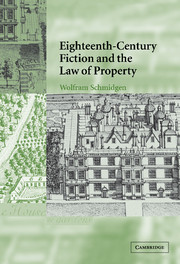Book contents
- Frontmatter
- Contents
- Acknowledgments
- Introduction
- 1 Communal form and the transitional culture of the eighteenth-century novel
- 2 Terra nullius, cannibalism, and the natural law of appropriation in Robinson Crusoe
- 3 Henry Fielding and the common law of plenitude
- 4 Commodity fetishism in heterogeneous spaces
- 5 Ann Radcliffe and the political economy of Gothic space
- 6 Scottish law and Waverley's museum of property
- Conclusion
- Notes
- Bibliography
- Index
1 - Communal form and the transitional culture of the eighteenth-century novel
Published online by Cambridge University Press: 22 September 2009
- Frontmatter
- Contents
- Acknowledgments
- Introduction
- 1 Communal form and the transitional culture of the eighteenth-century novel
- 2 Terra nullius, cannibalism, and the natural law of appropriation in Robinson Crusoe
- 3 Henry Fielding and the common law of plenitude
- 4 Commodity fetishism in heterogeneous spaces
- 5 Ann Radcliffe and the political economy of Gothic space
- 6 Scottish law and Waverley's museum of property
- Conclusion
- Notes
- Bibliography
- Index
Summary
Landed property must be a central focus in any study of the construction of community in eighteenth-century Britain. Although the advances in domestic manufacture and foreign trade in the second half of the eighteenth century tend to stand out most in accounts of the rise of industrialism, these advances were more than matched by the significant growth of agricultural productivity in the period. In addition to its crucial economic role, landed property remained, virtually undisputed until the end of the century, Britain's dominant social, political, and ideological paradigm. The rapid expansion of movable forms of property in the eighteenth century – commodities, stocks, credit – challenged the real and ideological dominance of immovable property, but the rapidity with which movables spread did not result in a quick or fundamental transformation of the established world of immovables. Even Adam Smith, who considered the wide distribution of increasingly various and refined commodities a crucial measure of the difference between “civilized” and “savage” societies, in the end projected a national economy that historically emerged from the gains made on the landed estate and continued to be grounded in agriculture, which for Smith represented a privileged figure of productivity and secure wealth. Landed property was too deeply entrenched, imaginatively and in fact, to be run over by what we have come to recognize, with good reason, as the “commercialization of eighteenth-century England.”
The combative language I have used here is, of course, questionable on a more fundamental level.
- Type
- Chapter
- Information
- Eighteenth-Century Fiction and the Law of Property , pp. 7 - 31Publisher: Cambridge University PressPrint publication year: 2002

